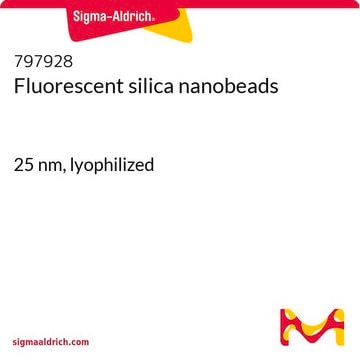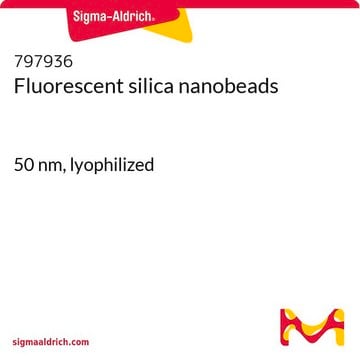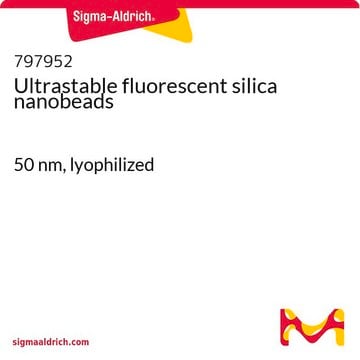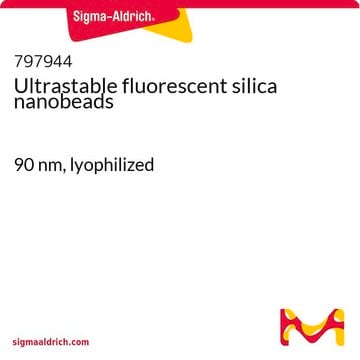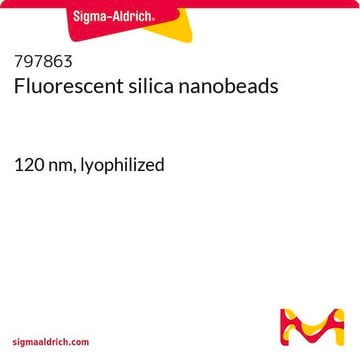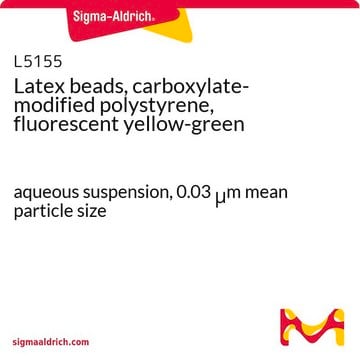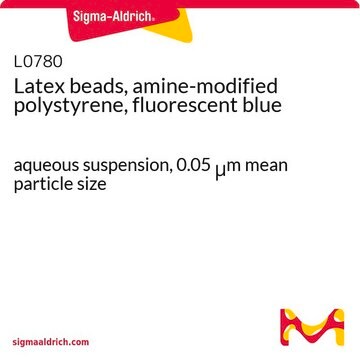The 25 nm nanobeads may exhibit high surface energy, making them prone to aggregation in solvent, which could explain the observed particle size of 300–800 nm in DLS measurements. It's also important to note that the 30% amplitude setting does not provide a clear indication of the actual power being applied during sonication. For better results, it is generally recommended to use a protocol of 1 second on with 3 seconds off for a total of 15 minutes under 400 Watts. Additionally, checking TEM images for the particle size, if available, may provide more accurate information on the actual size of the nanobeads.
797901
Ultrastable fluorescent silica nanobeads
25 nm, lyophilized
Synonyme(s) :
Fluorescent beads, Fluorescent nanoparticles, Silica nanoparticles
Sélectionner une taille de conditionnement
579,00 $
Sélectionner une taille de conditionnement
About This Item
579,00 $
Produits recommandés
Niveau de qualité
Forme
powder
Taille des particules
25 nm
Fluorescence
λem 590 nm
Absorption UV
λ: 570 nm Amax
Température de stockage
2-8°C
Vous recherchez des produits similaires ? Visite Guide de comparaison des produits
Application
Code de la classe de stockage
11 - Combustible Solids
Classe de danger pour l'eau (WGK)
WGK 3
Point d'éclair (°F)
Not applicable
Point d'éclair (°C)
Not applicable
Faites votre choix parmi les versions les plus récentes :
Déjà en possession de ce produit ?
Retrouvez la documentation relative aux produits que vous avez récemment achetés dans la Bibliothèque de documents.
Les clients ont également consulté
Articles
RAFT polymerization controls chain growth, yields defined polymers without cytotoxic heavy metals like ATRP.
Biomaterials science integrates smart materials into biological research, requiring a deep understanding of biological systems.
-
I applied probe sonication on ice for 8 minutes at 30% amplitude. However, the DLS size measurement results showed the particle size of is around 300–800 nm, which differs from the product description (25 nm). How?
1 answer-
Helpful?
-
-
Are these PFA-fixable?
1 answer-
A specific PFA Fixation study is not performed on this material. The literature around this topic seems to suggest this is a possible use for this product and more details can be found below.
Chiou AE, Hinckley JA, Khaitan R, Varsano N, Wang J, Malarkey HF 5th, Hernandez CJ, Williams RM, Estroff LA, Weiner S, Addadi L, Wiesner UB, Fischbach C. Fluorescent Silica Nanoparticles to Label Metastatic Tumor Cells in Mineralized Bone Microenvironments. Small. 2021 Apr;17(15):e2001432. doi: 10.1002/smll.202001432. Epub 2020 May 28. PMID: 32462807; PMCID: PMC7704907.
Further application information can be found on the website through the link below.
Helpful?
-
-
what is dispersibility of this beads in water.
1 answer-
The nanopowder may be re-dispersed by adding water directly to the storage vial. It is recommended to add 1 mL of water per each 1 mg of nanoparticles to be re-dispersed, and probe sonicating on ice for 8 minutes at 30% amplitude or until the powder has completely re-dissolved.
Helpful?
-
Active Filters
Notre équipe de scientifiques dispose d'une expérience dans tous les secteurs de la recherche, notamment en sciences de la vie, science des matériaux, synthèse chimique, chromatographie, analyse et dans de nombreux autres domaines..
Contacter notre Service technique